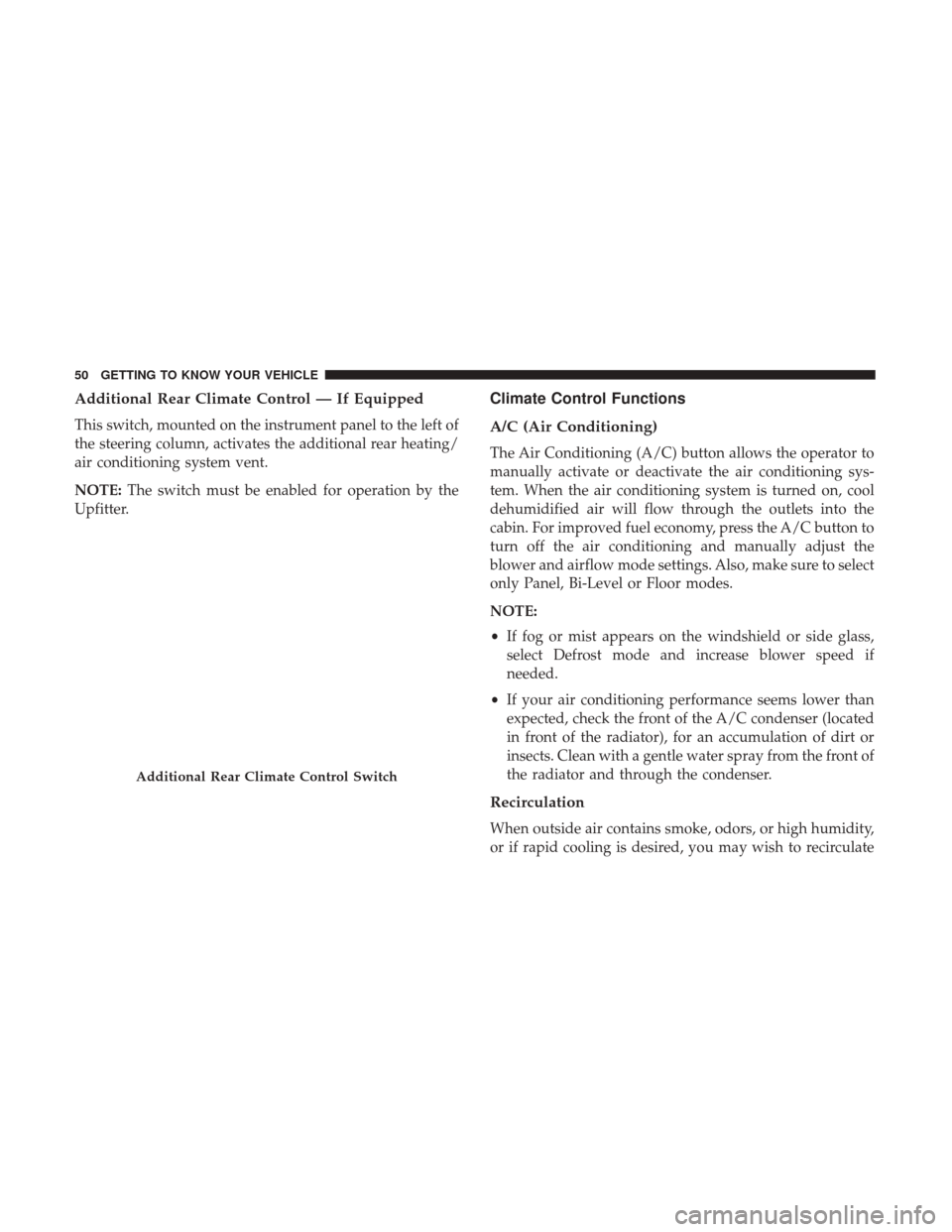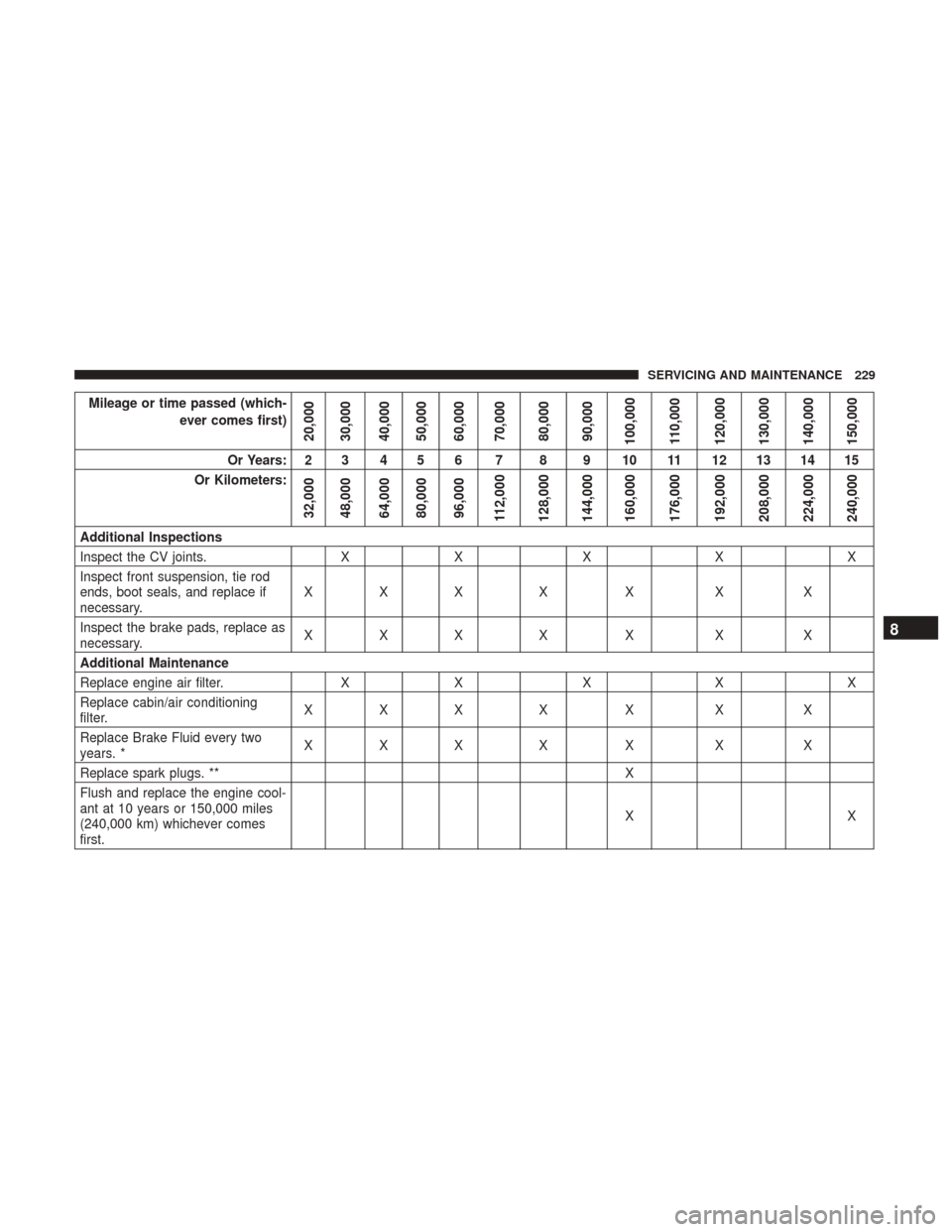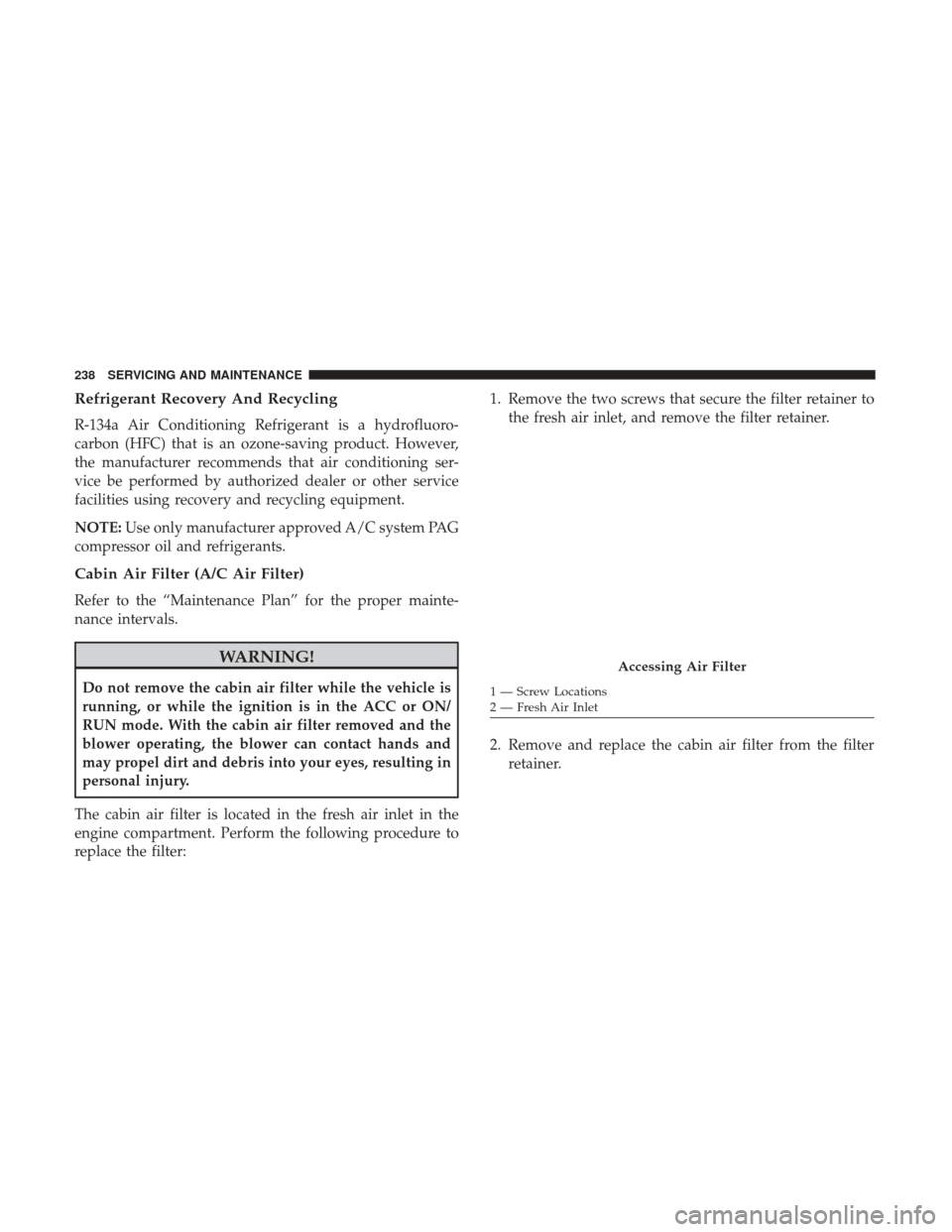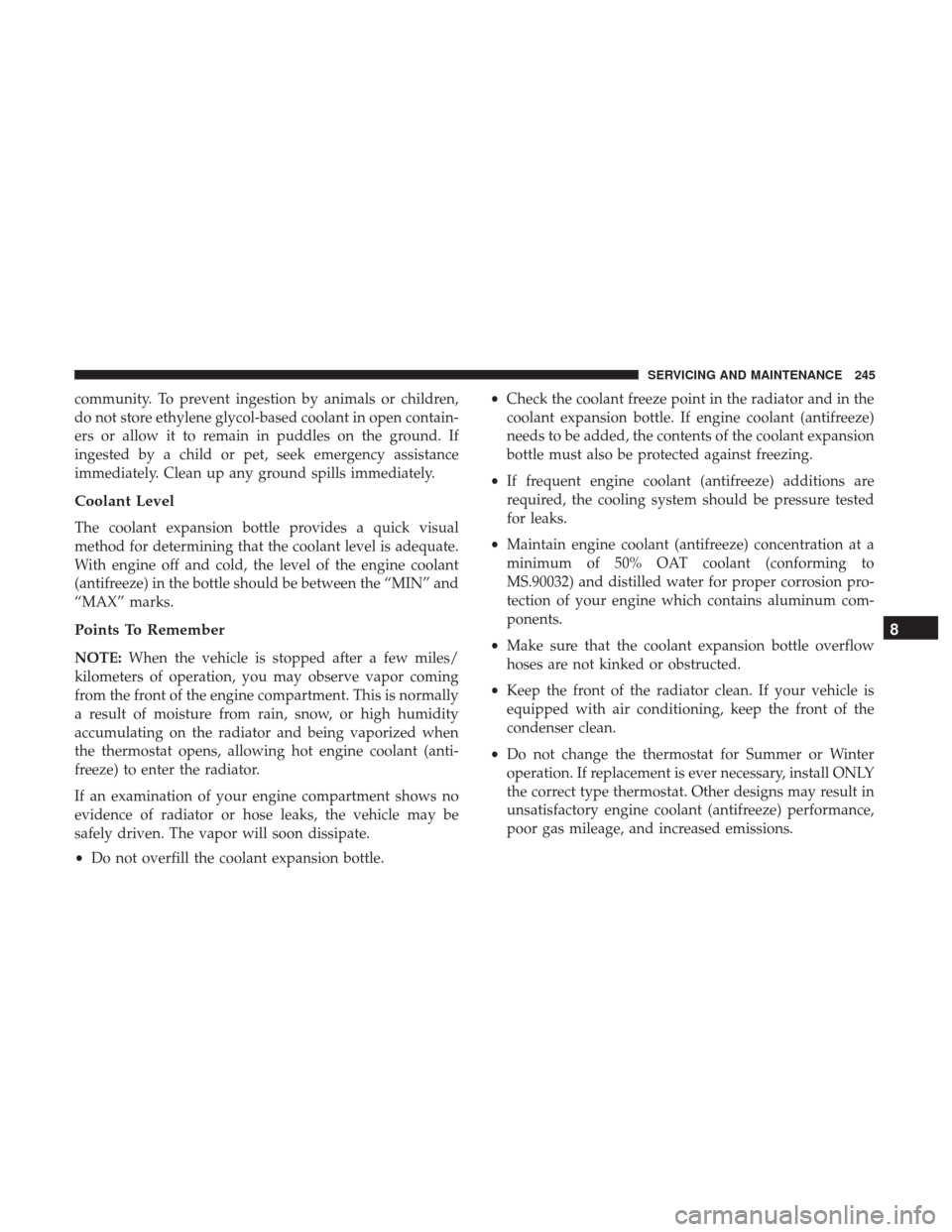air conditioning Ram ProMaster 2018 Owner's Manual
[x] Cancel search | Manufacturer: RAM, Model Year: 2018, Model line: ProMaster, Model: Ram ProMaster 2018Pages: 337, PDF Size: 4.13 MB
Page 48 of 337

Manual Climate Control Overview
The Manual Temperature Controls consist of a series of
three outer rotary dials (blower speed, temperature and
mode) and three inner push buttons (Recirculation, A/C,
Rear Window Defroster).
Manual Climate Control Descriptions
IconDescription
A/C Button
Push the A/C button to engage the Air Conditioning (A/C). A LED will illuminate when the
A/C system is engaged.
Manual Temperature Controls
46 GETTING TO KNOW YOUR VEHICLE
Page 52 of 337

Additional Rear Climate Control — If Equipped
This switch, mounted on the instrument panel to the left of
the steering column, activates the additional rear heating/
air conditioning system vent.
NOTE:The switch must be enabled for operation by the
Upfitter.
Climate Control Functions
A/C (Air Conditioning)
The Air Conditioning (A/C) button allows the operator to
manually activate or deactivate the air conditioning sys-
tem. When the air conditioning system is turned on, cool
dehumidified air will flow through the outlets into the
cabin. For improved fuel economy, press the A/C button to
turn off the air conditioning and manually adjust the
blower and airflow mode settings. Also, make sure to select
only Panel, Bi-Level or Floor modes.
NOTE:
• If fog or mist appears on the windshield or side glass,
select Defrost mode and increase blower speed if
needed.
• If your air conditioning performance seems lower than
expected, check the front of the A/C condenser (located
in front of the radiator), for an accumulation of dirt or
insects. Clean with a gentle water spray from the front of
the radiator and through the condenser.
Recirculation
When outside air contains smoke, odors, or high humidity,
or if rapid cooling is desired, you may wish to recirculate
Additional Rear Climate Control Switch
50 GETTING TO KNOW YOUR VEHICLE
Page 174 of 337

Automatic Transmission
The DRIVE range can be selected when towing. The
transmission controls include a drive strategy to avoid
frequent shifting when towing. However, if frequent shift-
ing does occur while in DRIVE, select TOW/HAUL mode
or select a lower gear range (using the Electronic Range
Select (ERS) shift control).
NOTE:Using TOW/HAUL mode or selecting a lower
gear range (using the ERS shift control) while operating the
vehicle under heavy loading conditions will improve per-
formance and extend transmission life by reducing exces-
sive shifting and heat build up. This action will also
provide better engine braking.
When towing a loaded trailer up steep grades at low
speeds, holding your vehicle in first gear (using the ERS
shift control) can help to avoid transmission overheating.
Tow/Haul Mode
To reduce potential for automatic transmission overheat-
ing, activate TOW/HAUL mode when driving in hilly
areas, or select a lower gear range (using the Electronic
Range Select (ERS) shift control) on more severe grades.
Speed Control — If Equipped
• Do not use on hilly terrain or with heavy loads.
• When using the speed control, if you experience speed
drops greater than 10 mph (16 km/h), disengage until
you can get back to cruising speed.
• Use speed control in flat terrain and with light loads to
maximize fuel efficiency.
Cooling System
To reduce potential for engine and transmission overheat-
ing, take the following actions:
• City Driving
• In city traffic — while stopped, place the transmission in
NEUTRAL, but do not increase engine idle speed.
• Highway Driving
• Reduce speed.
• Air Conditioning
• Turn off temporarily.
172 STARTING AND OPERATING
Page 231 of 337

Mileage or time passed (which-ever comes first)
20,000
30,000
40,000
50,000
60,000
70,000
80,000
90,000
100,000
110,000
120,000
130,000
140,000
150,000
Or Years: 2 3 4 5 6 7 8 9 10 11 12 13 14 15
Or Kilometers:
32,000
48,000
64,000
80,000
96,000
112,000
128,000
144,000
160,000
176,000
192,000
208,000
224,000
240,000
Additional Inspections
Inspect the CV joints. XX X XX
Inspect front suspension, tie rod
ends, boot seals, and replace if
necessary. XXX X X X X
Inspect the brake pads, replace as
necessary. XXX X X X X
Additional Maintenance
Replace engine air filter. XX X XX
Replace cabin/air conditioning
filter. XXX X X X X
Replace Brake Fluid every two
years. * XXX X X X X
Replace spark plugs. ** X
Flush and replace the engine cool-
ant at 10 years or 150,000 miles
(240,000 km) whichever comes
first. XX
8
SERVICING AND MAINTENANCE 229
Page 239 of 337

NOTE:Be sure to follow the “Severe Duty Conditions”
maintenance interval if applicable.
WARNING!
The air induction system (air cleaner, hoses, etc.) can
provide a measure of protection in the case of engine
backfire. Do not remove the air induction system (air
cleaner, hoses, etc.) unless such removal is necessary
for repair or maintenance. Make sure that no one is
near the engine compartment before starting the ve-
hicle with the air induction system (air cleaner, hoses,
etc.) removed. Failure to do so can result in serious
personal injury.
Engine Air Cleaner Filter Selection
The quality of replacement engine air cleaner filters varies
considerably. Only high quality filters should be used to
assure most efficient service. Mopar engine air cleaner
filters are a high quality filter and are recommended.
Air Conditioner Maintenance
For best possible performance, your air conditioner should
be checked and serviced by an authorized dealer at the
start of each warm season. This service should include cleaning of the condenser fins and a performance test.
Drive belt tension should also be checked at this time.
WARNING!
•
Use only refrigerants and compressor lubricants ap-
proved by the manufacturer for your air conditioning
system. Some unapproved refrigerants are flam-
mable and can explode, injuring you. Other unap-
proved refrigerants or lubricants can cause the sys-
tem to fail, requiring costly repairs. Refer to
Warranty Information Book, for further warranty
information.
• The air conditioning system contains refrigerant un-
der high pressure. To avoid risk of personal injury or
damage to the system, adding refrigerant or any
repair requiring lines to be disconnected should be
done by an experienced technician.
CAUTION!
Do not use chemical flushes in your air conditioning
system as the chemicals can damage your air condition-
ing components. Such damage is not covered by the
New Vehicle Limited Warranty.
8
SERVICING AND MAINTENANCE 237
Page 240 of 337

Refrigerant Recovery And Recycling
R-134a Air Conditioning Refrigerant is a hydrofluoro-
carbon (HFC) that is an ozone-saving product. However,
the manufacturer recommends that air conditioning ser-
vice be performed by authorized dealer or other service
facilities using recovery and recycling equipment.
NOTE:Use only manufacturer approved A/C system PAG
compressor oil and refrigerants.
Cabin Air Filter (A/C Air Filter)
Refer to the “Maintenance Plan” for the proper mainte-
nance intervals.
WARNING!
Do not remove the cabin air filter while the vehicle is
running, or while the ignition is in the ACC or ON/
RUN mode. With the cabin air filter removed and the
blower operating, the blower can contact hands and
may propel dirt and debris into your eyes, resulting in
personal injury.
The cabin air filter is located in the fresh air inlet in the
engine compartment. Perform the following procedure to
replace the filter: 1. Remove the two screws that secure the filter retainer to
the fresh air inlet, and remove the filter retainer.
2. Remove and replace the cabin air filter from the filter retainer.
Accessing Air Filter
1 — Screw Locations
2 — Fresh Air Inlet
238 SERVICING AND MAINTENANCE
Page 247 of 337

community. To prevent ingestion by animals or children,
do not store ethylene glycol-based coolant in open contain-
ers or allow it to remain in puddles on the ground. If
ingested by a child or pet, seek emergency assistance
immediately. Clean up any ground spills immediately.
Coolant Level
The coolant expansion bottle provides a quick visual
method for determining that the coolant level is adequate.
With engine off and cold, the level of the engine coolant
(antifreeze) in the bottle should be between the “MIN” and
“MAX” marks.
Points To Remember
NOTE:When the vehicle is stopped after a few miles/
kilometers of operation, you may observe vapor coming
from the front of the engine compartment. This is normally
a result of moisture from rain, snow, or high humidity
accumulating on the radiator and being vaporized when
the thermostat opens, allowing hot engine coolant (anti-
freeze) to enter the radiator.
If an examination of your engine compartment shows no
evidence of radiator or hose leaks, the vehicle may be
safely driven. The vapor will soon dissipate.
• Do not overfill the coolant expansion bottle. •
Check the coolant freeze point in the radiator and in the
coolant expansion bottle. If engine coolant (antifreeze)
needs to be added, the contents of the coolant expansion
bottle must also be protected against freezing.
• If frequent engine coolant (antifreeze) additions are
required, the cooling system should be pressure tested
for leaks.
• Maintain engine coolant (antifreeze) concentration at a
minimum of 50% OAT coolant (conforming to
MS.90032) and distilled water for proper corrosion pro-
tection of your engine which contains aluminum com-
ponents.
• Make sure that the coolant expansion bottle overflow
hoses are not kinked or obstructed.
• Keep the front of the radiator clean. If your vehicle is
equipped with air conditioning, keep the front of the
condenser clean.
• Do not change the thermostat for Summer or Winter
operation. If replacement is ever necessary, install ONLY
the correct type thermostat. Other designs may result in
unsatisfactory engine coolant (antifreeze) performance,
poor gas mileage, and increased emissions.
8
SERVICING AND MAINTENANCE 245
Page 274 of 337

WARNING!
The temperature grade for this tire is established for
a tire that is properly inflated and not overloaded.
Excessive speed, under-inflation, or excessive load-
ing, either separately or in combination, can cause
heat buildup and possible tire failure.
STORING THE VEHICLE
If you are storing your vehicle for more than 21 days, we
recommend that you take the following steps to minimize
the drain on your vehicle’s battery:
• Disconnect the negative cable from battery.
• Any time you store your vehicle or keep it out of service
(i.e., vacation) for two weeks or more, run the air
conditioning system at idle for about five minutes in the
fresh air and high blower setting. This will ensure
adequate system lubrication to minimize the possibility
of compressor damage when the system is started again.
BODYWORK
Protection From Atmospheric Agents
Vehicle body care requirements vary according to geo-
graphic locations and usage. Chemicals that make roads
passable in snow and ice and those that are sprayed on
trees and road surfaces during other seasons are highly
corrosive to the metal in your vehicle. Outside parking,
which exposes your vehicle to airborne contaminants, road
surfaces on which the vehicle is operated, extreme hot or
cold weather and other extreme conditions will have an
adverse effect on paint, metal trim, and underbody protec-
tion.
The following maintenance recommendations will enable
you to obtain maximum benefit from the corrosion resis-
tance built into your vehicle.
What Causes Corrosion?
Corrosion is the result of deterioration or removal of paint
and protective coatings from your vehicle.
The most common causes are:
• Road salt, dirt and moisture accumulation.
• Stone and gravel impact.
• Insects, tree sap and tar.
272 SERVICING AND MAINTENANCE
Page 324 of 337

Adding Engine Coolant (Antifreeze).............243
Adding Washer Fluid ....................... .233
Additives, Fuel ........................... .282
AirBag..................................112 Air Bag Operation ........................114
Air Bag Warning Light .....................111
Enhanced Accident Response ................222
Event Data Recorder (EDR) .................223
If A Deployment Occurs ....................119
Maintaining Your Air Bag System .............122
Side Air Bags ...........................115
Transporting Pets ....................... .130
Air Bag Light ....................... .74, 111, 131
Air Bag Maintenance ....................... .122
Air Cleaner, Engine (Engine Air Cleaner Filter) ......236
Air Conditioner Maintenance ..................237
Air Conditioning Filter ....................52, 238
Air Conditioning, Operating Tips .............51, 53
Air Conditioning Refrigerant ...............237, 238
Air Conditioning System .....................237
Air Filter ............................... .236
Air Pressure, Tires ......................... .259
Alarm (Security Alarm) .......................21
Alarm System (Security Alarm) .................21
Alterations/Modifications, Vehicle ................6Antifreeze (Engine Coolant)
................242, 286
Disposal .............................. .244
Anti-Lock Brake System (ABS) ..................88
Anti-Lock Warning Light ......................80
Assist, Hill Start ............................94
Audio Systems (Radio) ...................... .290
Auto Down Power Windows ...................54
Automatic Door Locks ........................23
Automatic Transaxle .........................18
Automatic Transmission ..................140, 248
Adding Fluid .......................... .248
Fluid And Filter Changes ...................248
Fluid Change .......................... .248
Fluid Level Check .................... .247, 248
Fluid
Type ......................... .247, 288
Special Additives ........................ .247
Battery .............................. .75, 233
Charging System Light .....................75
Keyless Key Fob Replacement ................17
Belts, Seat ............................... .131
Body Builders Guide ..........................6
Body Mechanism Lubrication ..................239
B-Pillar Location .......................... .254
Brake Assist System .........................90
322 INDEX
Page 327 of 337

Compartment.......................... .232
Compartment Identification .................232
Coolant (Antifreeze) ...................242, 286
Cooling .............................. .241
Exhaust Gas Caution ...................131, 285
Fails To Start ........................... .137
Flooded, Starting ........................ .137
Fuel Requirements ....................282, 286
Jump Starting .......................... .214
Oil .............................. .235, 286
Oil Filler Cap .......................... .232
Oil Filter .............................. .236
Oil Selection ........................ .235, 286
Oil Synthetic ........................... .236
Overheating ........................... .218
Starting .............................. .137
Engine Oil Viscosity ........................ .235
Engine Oil Viscosity Chart ....................235
Enhanced Accident Response Feature ............222
Entry System, Illuminated .....................44
Ethanol ................................. .283
Exhaust Gas Caution .....................131, 285
Exhaust System ....................... .131, 240
Exterior Lighting ............................39 Exterior Lights
......................... .38, 133
Filters Air Cleaner ............................ .236
Air Conditioning ..................... .52, 238
Engine Oil ......................... .236, 286
Engine Oil Disposal ...................... .236
Flashers Hazard Warning ........................ .179
Turn Signal ......................... .82, 133
Flooded Engine Starting ..................... .137
Fluid Capacities ........................... .286
Fluid Leaks .............................. .134
Fluid Level Checks Automatic
Transmission ....................248
Brake ................................ .246
Cooling System ......................... .242
Power Steering ......................... .150
Fluids And Lubricants ...................... .286
Fog Lights ................................40
Folding Rear Seat ...........................23
Four-Way Hazard Flasher .....................179
Freeing A Stuck Vehicle ..................... .219
Fuel ................................... .282
Additives ............................. .282
12
INDEX 325